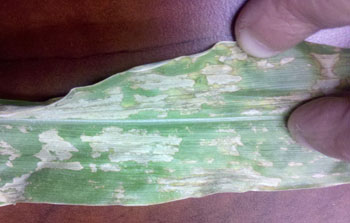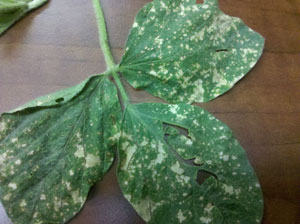With the rapid start to the 2012 crop season, plant development may be further along than you'd like for some field activities. Since many corn fields have reached the V8 growth stage and many soybean fields have well developed plant canopies already, there are a few things to consider before making fertilizer and herbicide applications.
First, if you are going to apply liquid fertilizer, in order to prevent burning on corn (Figure 1) and soybean leaves (Figure 2), consider using drop nozzles. Placing nozzles below the top of the canopy can reduce injury from fertilizer use.
Second, before making a late season herbicide application, thoroughly scout the field and make sure there is a need for the herbicide. Prophylactic use of contact herbicides, such as glyphosate, is not recommended. This will only incur unnecessary expenses and will have no residual effect on weeds which have not yet germinated. Additionally, if the applications do not control all of the weeds in the field, it will create greater selection pressure for resistant weeds.
Third, always read and follow the label. As plants progress rapidly, it may be tempting to make a herbicide application just after what is recommended on the label. This is not a good idea though. Besides being illegal, the label requirements on herbicide labels are there to prevent yield loss. Applying glyphosate or other herbicides at growth stages beyond those recommended on the label can cause unseen yield loss.
As you progress throughout the season, keep in mind that little decisions can make big differences in the piggybank. If you can manage weeds early and supply adequate nitrogen without causing plant damage, the season will be much more prosperous.
|
|
|

 Figure 1. Leaf burn from nitrogen applications on corn can be aesthetically displeasing for growers, however, the plants will grow out of the damage. (Photos by Brandy VanDeWalle)
Figure 1. Leaf burn from nitrogen applications on corn can be aesthetically displeasing for growers, however, the plants will grow out of the damage. (Photos by Brandy VanDeWalle) Figure 2. Nitrogen burn on soybean leaves is similar to corn with patches of localized necrosis where nitrogen concentrations were the greatest.
Figure 2. Nitrogen burn on soybean leaves is similar to corn with patches of localized necrosis where nitrogen concentrations were the greatest.




Post a comment
Report Abusive Comment